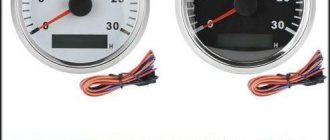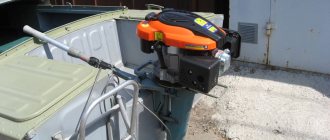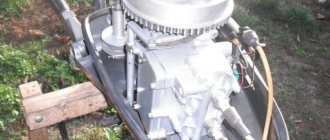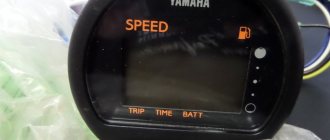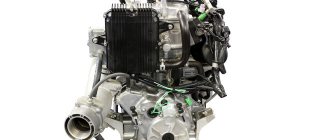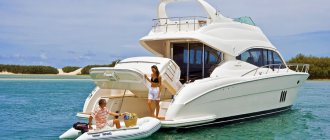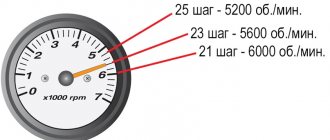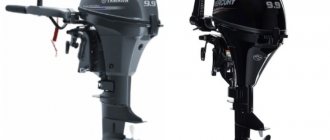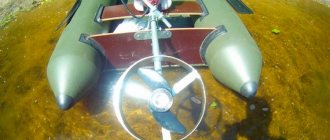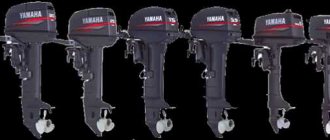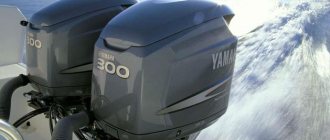Today, boats have entered the lives of many people. For some it is a hunting or fishing vehicle, for others it is simply equipment for a relaxing holiday, and for others it is a means of transportation. The old boat options, where you had to work with oars, have already gone out of fashion. Designs on which motors are installed are now popular. But not everyone knows how they work and what a propeller is.
Read about how to make transom wheels with your own hands? You may also be interested in our material on creating a hinged transom for a boat.
Review of the propeller for a Yamaha outboard motor
A properly selected propeller not only ensures that the boat quickly reaches its maximum speed, but also guarantees a long service life of the outboard motor. And taking into account the peculiarities of the propeller’s operation under different loads of the boat itself and different engine speeds, the most optimal solution would be several spare propellers with different characteristics.
Disadvantages of steel screws
The most important and significant disadvantage is the inflated cost, significantly higher than the price of analogues.
For example, aluminum samples have a lower price. In addition, a significant disadvantage of steel is the likelihood of damage when hitting something hard, despite the fact that often all damage can be easily eliminated by straightening (Fig. 5).
Fig. 5 – Defects in a steel screw.
Often the steel propeller itself may remain intact, but will cause significant damage to the gearbox, which will ultimately affect the overall operation of the motor.
How propellers work
The first invention, similar to the modern propeller, is attributed to Archimedes, and was used to lift water, and not to propel boats. A propeller is a device whose operating principle is based on converting the rotation of the propeller shaft into the movement of the boat.
As a result of such a pressure difference, a lifting force arises, which in turn can be decomposed into two components:
- The propeller thrust is a force directed in the same direction as the direction of movement of the craft, depending on the angle of attack of the blade profile. If the angle differs from what is rational for a given boat, then in the case of a small angle the engine power will not be fully used, but in a situation with a larger angle than necessary, the engine power will be used to overcome the torque.
- Torque is a force that is directed perpendicular to the conditional line of motion of the vessel. To put it simply, this design of the propeller ensures the movement of the craft by sucking in a portion of water with the front part of the propeller, and then throwing it out at a higher speed with the rear part.
Propellers are classified according to the following parameters:
- pitch - the distance covered by the propeller in one full revolution around its own axis;
- screw diameter;
- number of blades - most often found with 3, but can also be with 2, or with 7 or more;
- disk ratio - the ratio of the surface area of the propeller blades to the surface area of a circle of the same diameter;
- material of manufacture - steel, often stainless, less often carbon, an alloy based on aluminum or titanium, plastic;
- hub diameter;
- hub design – with the exhaust system ducted under the anti-cavitation plate, or through the hub.
What is it and what does it represent?
Nowadays the most popular propulsion device for water transport is the propeller.
Such a mechanism consists of two main parts - blades and hub. The blades are installed with equal distances from one another and are at the same angle in relation to the plane of the torque.
This entire system is installed on propeller shafts, which begin to rotate when the boat engine is turned on, with a power of 40-60 hp.
When all the elements begin to move, the blades take in water and immediately throw it back, giving it an impulse that passes to the blades, propeller shaft, and the hull of the boat.
Modern rowing designs come in different sizes. To select the size, you just need to determine two numbers.
- The first will be the diameter. If the propeller is equipped with 2 or 4 blades, then the diameter can be determined simply by measuring the length of the section between the edges of the opposing blades. It will be more difficult if 3 blades are installed. Here you need to measure the area between the middle of the bushing and the edge of one of the blades. The result obtained must be doubled to obtain the diameter.
- Step size. The second number to determine the size will be the pitch (the distance that the screw travels in one whole circle).
This means that if there is a screw with a diameter of 40 cm and a pitch of 55 cm, then the size of the mechanism will be determined by the marking on board “40x55”.
The bushing is also considered an important part. The function of this component is to center the mechanism on the drive shaft.
The propellers, which in most modern boats also serve as an exhaust outlet, are also equipped with a cage around the hub and attached blades.
How to choose a screw
The choice of propeller for installation on a boat motor should be influenced by more than just its pitch. The diameter, disk ratio, material of manufacture, as well as the manufacturing company are also important.
Instructions
- the best choice would be to give preference to a well-known manufacturer, such as, for example, Solas or Michigan;
- for small boats, propellers made of plastic or aluminum are quite suitable;
- Stainless steel is suitable for relatively larger boats with powerful motors.
Characteristics
The main characteristics of propellers are propeller pitch, diameter, disc ratio and slip.
All parameters are interconnected and the optimal value of each of them is determined by the manufacturer at the design stage. For example, motors with a power of 20-30 hp. usually come complete with a 9.9*12 screw, where 9.9 is the diameter and 12 is the pitch of the screw.
Also, such characteristics as the thickness of the blade profile and their surface area affect the speed at which such an undesirable effect as cavitation occurs. Cavitation is essentially the boiling of air bubbles due to the formation of an area of very low pressure.
Small bubbles merge into large ones, and when they reach a certain size they can damage the screw itself.
The onset of cavitation is indicated by the following phenomena:
- the movement of the vessel is jerky, spasmodic;
- hull vibration, which is transmitted from the propeller;
- the appearance of extraneous noise in the operation of the propeller;
- When the number of revolutions per minute on the tachometer increases, the speed of the boat does not increase.
Principles for selecting propellers for boats
The propeller pitch is one of the defining technical characteristics that has a direct impact on the time during which the ship can reach its highest speed (Fig. 8). It also demonstrates the distance that the selected ridge screw is capable of in 1 full revolution. As a rule, this value is measured in inches.
Fig. 8 – Scheme of screw pitch for 1 full revolution.
It is believed that the higher the screw pitch, the stronger the thrust generated when the blades rotate. The emphasis itself subsequently turns into energy that can influence the speed of the motor boat. Consequently, it has a direct effect on the number of engine revolutions over a certain period of time. If the step itself is smaller, the number of revolutions will also decrease.
When choosing a specific type, you need to understand that almost all motor and boat characteristics will depend on it. In this case, it is necessary to observe the values of indicators that must meet the requirements for a particular model of outboard motor. This will help stabilize the operation of the motor on boats at the time of movement, saving the engine from early breakdown in advance.
Speed screws
To increase the speed of the boat you can:
- Replace the plastic or aluminum screw with one made of stainless steel with a good polish. However, it is worth remembering that if boats with steel propellers hit snags, they risk damaging the gearbox, but in the case of plastic, only the propeller is damaged.
- To achieve maximum speed for a swimming craft, it is recommended to look for a special high-speed propeller with the highest possible efficiency at high speeds. When installing such propellers, an increase in the number of revolutions may be observed, which needs to be corrected either by the pitch of the propeller, or by replacing a 3-bladed propeller with a 4-bladed propeller.
- If a standard propeller is installed, it may make sense to install a propeller with a larger pitch and smaller diameter - this will allow the engine to reach higher speeds, which will have a positive effect on speed. In this case, you should especially carefully monitor the tachometer readings at “full throttle” so that the number of revolutions per minute does not exceed the maximum permissible values for a particular model.
What types are there and how to choose them correctly?
At first, these mechanisms were produced mainly from brass.
Today, the specialty store market offers a selection of many options.
The most popular ones now are steel, aluminum and composite structures. Each type has its own advantages and disadvantages.
Aluminum
This type is most often used for Yamaha outboard motors and stern drives. The advantages of aluminum options are:
- Affordable price. Therefore, they are often chosen by boat and motor manufacturers;
- High speed. Compared to traditional brass screws, aluminum designs rotate much faster;
- Lightness of the mechanism. This aspect is very important when transporting a boat;
Thanks to modern equipment and technologies, new aluminum structures show excellent results, which allows them to be considered an ideal price-quality ratio.
Therefore, many small boats are equipped with just such a mechanism.
Steel
Stainless steel, as the basis of the screw design, is an ideal option for people who value reliability and efficiency.
According to research results, steel blades are 7 times stronger than aluminum blades.
And this allows you to select thinner and lighter options.
Also, the steel type is highly durable; it can withstand impacts from underwater rocks without much damage. But such a collision can end badly for the gearbox. Given this, manufacturers are trying to solve the problem. To do this, place a plastic sleeve on the steel screw.
In emergency situations, it will be cut off or simply rotate, as in the aluminum version, and will not deform like a steel product.
Now on the market for boat accessories you can find ground and polished steel options.
There are many rumors that the second option is more reliable and effective, but in fact, polishing does not affect the operation of the structure, but only its appearance.
If we take the quantitative ratio, then for 70 boats there are approximately 40 steel propellers, 20 aluminum and 10 others.
Composite
One of the latest developments in the field of rowing structures are devices made of composite materials.
Advances in modern chemistry make it possible to widely use carbon and nylon fibers in the production of transport equipment.
Compared to the aluminum version, the composite one is much more reliable. And when choosing between steel and composite, the latter boasts rust resistance.
“HOW TO CHOOSE A PROPELLER FOR A YAMAHA MOTOR.”
After purchasing a Yamaha outboard motor for the first time, it is very important to decide which propeller it will be used with. Technical section of YAMAHA Boat Motors
As practice shows, each specific case requires its own screw. First of all, you need to carefully study the operating instructions for your Yamaha outboard motor. I very rarely want to study it, but this is the requirement of the time. The technology is too complex and does not forgive mistakes and inattention. But repairs are much more expensive than several hours of reading literature, and Russians are the most “reading nation.”
There are also some general guidelines to consider... Select a propeller for your outboard motor so that the motor reaches the upper operating speed range at full throttle when the boat is fully loaded. In general, for boats with a small load you should buy a propeller with a large pitch, and for heavy boats - a propeller with a smaller pitch. If you use the boat with a different load each time, then using only one propeller will not work. It is worth purchasing several propellers, one of which would cope well with the maximum load, the second for an empty boat. I can also note that the presence of two or more propellers in a boat is also passive safety!
Typically, Yamaha outboard motors are sold with an aluminum mid-pitch propeller already installed. It is better for you to decide whether to change this propeller or buy a spare one after a test ride on the boat.
Below are recommendations that will help you choose the right standard propeller for YAMAHA Outboard Motors
When choosing a screw, you need to know two main parameters: its diameter and pitch. The screw pitch is the imaginary distance in inches or millimeters that the screw travels in one revolution (see figure on the left). The pitch is indicated in inches on the hub of the propeller itself. For example, for a two-stroke or four-stroke Yamaha outboard motor with a power of 20 to 30 horsepower, a standard 9.9x12 propeller is included. This means that such a screw has a diameter of 9.9 inches and a pitch of 12 inches. Also, original Yamaha propellers also have a special mark in the designation of the propeller, which indicates the mounting dimensions of the propeller hub. Correctly determine the VIN of YAMAHA Outboard Motors
A Yamaha outboard motor that does not develop its rated speed when the throttle valve is fully open is essentially “choking” on fuel. This greatly increases the load on valves, pistons and bearings. Excessive fuel consumption occurs. The boat motor may overheat. Detonation, jamming and burnout of the piston, and general damage to the motor can also occur - all due to an incorrectly selected propeller. On the other hand, exceeding the maximum speed of a Yamaha outboard motor also leads to engine overloads and possible destruction of the petal valves (in 2-stroke engines), accelerates wear of all parts, and also contributes to overheating. And, as a result, the outboard motor can jam and fail prematurely. But Yamaha are the most reliable engines in the world!
Therefore, it is very important to correctly select the optimal propeller (screws) to ensure normal operating conditions for a Yamaha outboard motor. Choose a propeller for your outboard motor from the manufacturer's catalog, but remember that the best result may be achieved only on the basis of a test drive and thanks to the tachometer of your boat.?
The standard sizes of the original Yamaha propellers are designed in such a way that a change in the propeller pitch by 1 inch (2.54 cm) corresponds to a change in the speed of rotation of the propeller by 150-200 rpm. The speed of rotation of the propeller will also change if the three-blade propeller is replaced with a four-blade one! The change will be within 150-200 rpm.
I can say that a 4-bladed propeller will take off much faster and put the boat on the glider at the same pitch, BUT THE MAXIMUM SPEED WITH SUCH A PROPELLER WILL BE 3-5% LESS. Keep this in mind when selecting a screw. Also, for the sea you cannot take aluminum screws... - only stainless steel! Yamaha's line of proprietary propellers even includes anti-weed propellers that are suitable for fishermen.
If the initially selected propeller is "slowing" the boat and does not gain speed, try a propeller with a smaller pitch to increase the rotation speed. The larger the pitch of the propeller, the lower the speed of its rotation... and vice versa.
Find out from the instructions for the Yamaha engine what maximum number of revolutions it can develop with the throttle valve fully open (“full throttle”). The speed of rotation of the engine shaft can and should be measured with a tachometer (on many engines the tachometer is already included). As a rule, the speed should not exceed 5500-6000 rpm. Accelerate your boat with the selected propeller to maximum speed at “full throttle”. If the speed of your outboard motor, with the throttle fully open, is less than the maximum recommended speed, then you should simply reduce the propeller pitch. and vice versa. Remember that a 1 inch (2.54 cm) difference in propeller pitch corresponds to approximately 200 revolutions. It's not difficult to figure out which screw is needed.
